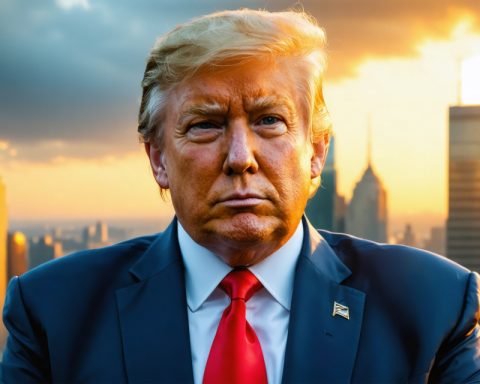- The White House Crypto Summit marks a pivotal moment in American finance, positioning the U.S. as a leader in digital finance innovation.
- The summit, directed by A.I. & Crypto Czar David Sacks and Bo Hines, seeks to address regulatory uncertainties and foster growth in blockchain and digital assets.
- Trump’s Executive Order 14178 emphasizes responsible growth, reflecting a shift from previous stringent regulatory approaches.
- The event symbolizes Trump’s strategic embrace of cryptocurrency as part of his pro-innovation leadership image, contrasting with past “war on digital assets.”
- Participants aim to integrate digital assets into the U.S. economy, gaining insights into future regulatory frameworks and economic opportunities.
- The summit is not just political theater but symbolizes a new chapter where innovation and regulation work together in digital finance.
A brisk March morning paints the backdrop for an event that may shift the contours of American finance. Donald Trump, often known for tapping into the zeitgeist, now positions himself as America’s digital pioneer as he hosts a landmark gathering—the first-ever White House Crypto Summit.
Within the historic walls of the White House, industry giants mingle with policymakers, a congregation with a common purpose: charting the future of blockchain and digital assets in the United States. The summit, steered by the dynamic David Sacks, the President’s A.I. & Crypto Czar, and the energetic Bo Hines, aims to place America at the forefront of digital finance evolution.
Cast against a backdrop of regulatory uncertainty, this summit emerges as a pivotal forum. Conversations that will occur here are set to untangle knots of regulatory ambiguity, spark financial innovation, and open new vistas of economic opportunity in a rapidly evolving digital sphere.
Earlier, Trump’s Executive Order 14178 had already laid the groundwork, underscoring his administration’s focus on the “responsible growth and use of digital assets.” This marks a significant shift from prior administrations’ stringent regulatory stances, providing the crypto-industry with a respite from relentless scrutiny.
Trump’s embrace of crypto is strategic, much more than a policy maneuver. His active engagement with advocates of digital finance reflects his ambition to be seen as a pro-innovation leader. He contrasts himself with what he describes as the previous administration’s “war on digital assets.” His call for a clear regulatory framework aims to nurture industry growth while protecting consumers, a balancing act that Washington has yet to master.
For those gathered here, the White House Crypto Summit is not just about policy but about embedding digital assets into the fabric of the nation’s economy. Attendees anticipate unprecedented access to decision-makers, offering insights into how cryptocurrencies and blockchain will weave into the financial system’s broader tapestry.
As the world watches, the summit becomes more than mere political theater—it is the dawn of a new chapter in American innovation, one where digital finance finds a home in the halls of power. For many, the takeaway is clear: under Trump’s administration, the U.S. intends to lead in digital finance, beckoning a future where innovation and regulation rise hand in hand.
The Future of Finance: How the White House Crypto Summit Shapes the American Digital Economy
The White House Crypto Summit, hosted against the brisk March backdrop, could potentially reshape American finance. While the event briefly mentioned in the article is significant, there are numerous angles and implications not fully explored. Let’s dive into additional facts and insights regarding the summit and the evolving landscape of digital finance in the United States.
Key Facts About the White House Crypto Summit
1. Regulatory Context: The summit occurs amidst a landscape of regulatory uncertainty surrounding digital assets. Following Executive Order 14178, the Trump administration is signaling a clear shift toward facilitating innovation rather than imposing strict regulatory controls.
2. Role of David Sacks and Bo Hines: These dynamic figures are steering the conversation, with David Sacks serving as the President’s A.I. & Crypto Czar, and Bo Hines, making strategic inroads with industry stakeholders to craft a policy environment that fosters growth.
3. Stakeholder Participation: Industry giants from blockchain technology companies, cryptocurrency exchanges, and regulatory bodies are in attendance. This diverse gathering is pivotal for consensus-building and future policy development.
4. Trump’s Strategic Positioning: Labeling himself as a digital pioneer, Trump seeks to leverage the summit to position the U.S. as a leader in digital finance. His administration’s balancing of innovation with consumer protection highlights a shift in approach compared to previous administrations.
How-To Steps & Life Hacks
– Navigating Regulatory Changes: For cryptocurrency businesses and investors, staying informed about evolving regulatory frameworks is crucial. Engaging with lobby groups and attending policy discussions can provide valuable insights.
– Leveraging Blockchain Technology: Organizations can explore blockchain’s potential for supply chain transparency, secure transactions, and decentralized finance (DeFi) innovations to enhance business operations.
Real-World Use Cases
– Central Bank Digital Currencies (CBDCs): The U.S. may explore its own digital currency, enhancing financial inclusion and faster transaction times. Countries like China already have pilot projects for digital yuan, setting competitive benchmarks.
– Cross-Border Payments: Blockchain technology offers a streamlined, efficient method for international money transfers, reducing costs and increasing transaction speed compared to traditional banking systems.
Market Forecasts & Industry Trends
– Rising Adoption of Digital Assets: According to a report by PwC, blockchain technology could boost global GDP by $1.76 trillion by 2030, with the financial sector leading this growth.
– Emerging Technology Ecosystem: Innovations in cryptocurrencies, NFTs (Non-Fungible Tokens), and decentralized applications are expected to expand, with sectors like gaming, art, and real estate showing increased blockchain integration.
Controversies & Limitations
– Volatility and Security Concerns: Cryptocurrencies are known for their price volatility and susceptibility to hacks. While regulation could provide stability, it may also stifle innovation if overly stringent.
– Environmental Impact: The energy consumption of cryptocurrency mining is a significant concern. Sustainability practices and greener alternatives are gaining attention within the industry.
Conclusion & Recommendations
As the White House Crypto Summit unfolds, stakeholders in the digital finance landscape should:
– Stay Informed: Regularly monitor policy changes and engage with industry forums to remain ahead in compliance and innovation.
– Innovate Responsibly: Balance technological advancements with ethical practices, ensuring security and sustainability.
– Explore New Markets: Evaluate the potential of digital assets in diverse sectors to capture emerging opportunities.
The evolving digital finance ecosystem holds promise but requires careful navigation of regulatory terrain to unlock its full potential. Under thoughtful leadership, as exemplified by recent policy shifts, the U.S. can indeed become a forerunner in digital finance innovation.
For more on technology and finance, check out TechCrunch and Investor.gov for investment insights.










